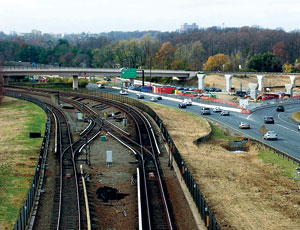The Federal Transit Administration approved last month the Metropolitan Washington Airport Authority’s revised testing plan for eleven 30-year-old foundations that will be used to support piers for the new Dulles Metrorail extension in northern Virginia to Dulles International Airport.

The concrete foundations, supported by concrete and steel caissons driven 50 to 60 ft deep, are among 13 that were installed by the Virginia Dept. of Transportation in the mid-1970s during construction of the Metrorail Orange Line, in anticipation of a future extension through the Dulles Corridor.
Although a 7-ft-dia column was built atop one of the foundations, the others were essentially lost until Dulles Transit Partners, MWAA’s design-build contractor, rediscovered them in 2008 during preliminary engineering for the project’s $2.6-billion first phase.
Eleven of the foundations were ideally aligned to be incorporated into the extension’s flyover across the westbound lanes of Interstate 66. Although DTP performed static load tests and visual inspections on two of the foundations, the project’s former bridge manager publicly charged that DTP was not doing enough to verify the foundations’ condition and structural stability, particularly since no as-builts could be located.
The accusations also rekindled concerns about MWAA’s ability to properly manage such a major design and construction effort, a factor that contributed to FTA delaying approval of the project’s $900-million New Starts funding application until early last year.
MWAA spokeswoman Tara Hamilton insists her agency and DTP did not shirk their responsibility to the project’s safety. “The 2008 tests were intended to make a preliminary assessment of their condition,” she says. “As the project moved toward final design, we would perform additional tests as needed.”
DTP spokesman Howard Menaker adds that, although those tests showed the foundations to be good shape, “we were prepared to do whatever additional testing is necessary to ensure that everyone is comfortable with their condition.”
At FTA’s request, MWAA submitted a new testing plan that calls for pile-driving analysis (PDA) dynamic load tests be performed on two piles in eight of the foundations. Static load tests are to be performed on at least one pile in the remaining three foundations, two of which present significant access challenges. One, sited at the convergence of I-66 and the Dulles Airport Access Road, will be accessed by tunneling. The other is located between the existing Orange Line tracks and will require a carefully coordinated service shutdown in order to perform the tests.
Each of the 70-ton piles in the 11 foundations must meet the same test criteria that is being used for the extension’s new pile foundations—225% of design capacity, or 158 tons.
MWAA and DTP will take other measures to ensure the foundations’ integrity, including performing stray-current tests, coring of re-used concrete pile caps and corrosion inspections.
In approving the test plan on Jan. 8, FTA Administrator Peter Rogoff reiterated that these steps “must demonstrate the needed focus and commitment to safety, which must characterize MWAA’s efforts on this project going forward.” FTA’s project management oversight contractor—Hill and Associates, Philadelphia—is to observe all testing, while MWAA’s quality-assurance/quality-control department will audit DTP’s design to ensure that test results are incorporated into the final design documents.
“The Airports Authority will proceed with the agreed testing plan,” Hamilton says, “and we look forward to working closely with the FTA to ensure that all the piers meet safety standards.”
Menaker says the tests will not affect plans to have the extension’s $2.6-billion first phase ready as scheduled by 2013. “We’ll do all the testing as we construct the piers during the first six months of this year,” he says. The 6 ft x 6 ft piers for the flyover will range in height from 11.5 ft to 42 ft.



Post a comment to this article
Report Abusive Comment